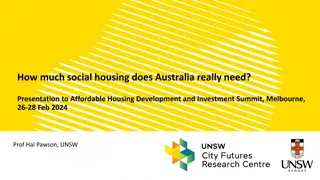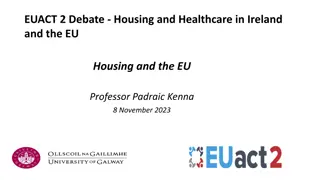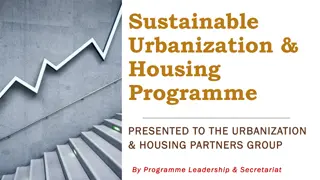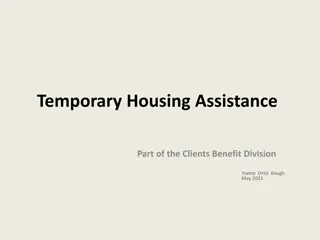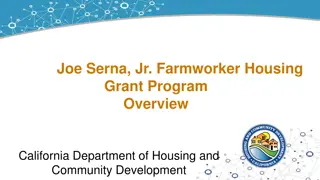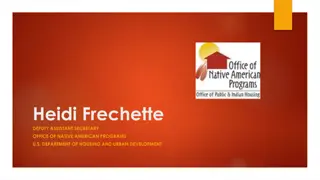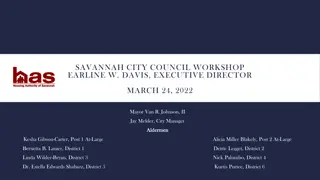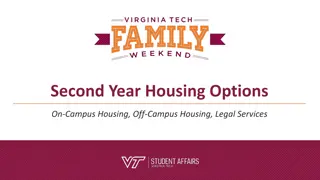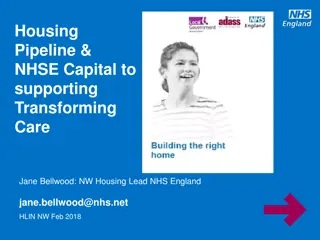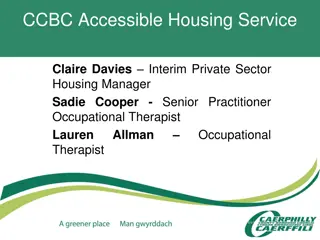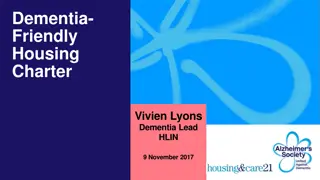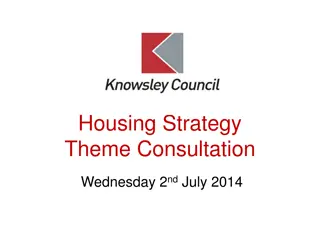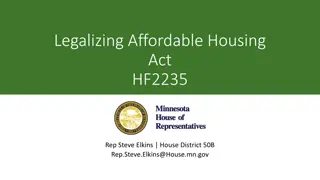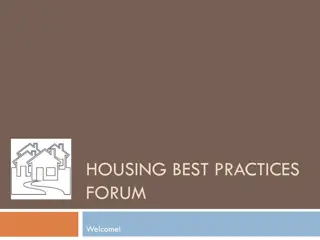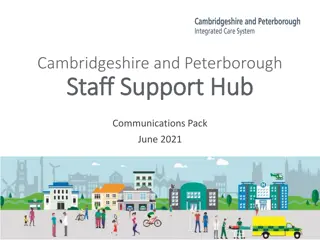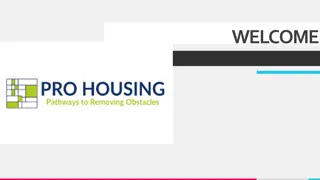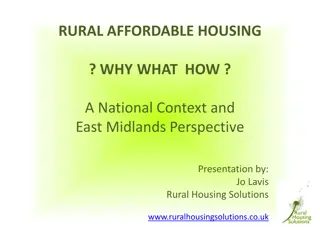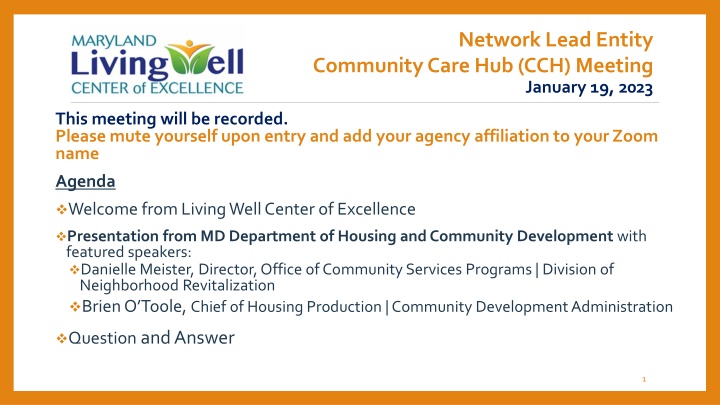
Community Care Hub Meeting - Supporting Housing and Service Needs
This meeting on January 19, 2023, will focus on supporting the housing and service needs of older adults through various programs and initiatives presented by key speakers and agencies. Topics include grant activities, DHCD programs, preventing homelessness, and more.
Download Presentation

Please find below an Image/Link to download the presentation.
The content on the website is provided AS IS for your information and personal use only. It may not be sold, licensed, or shared on other websites without obtaining consent from the author. If you encounter any issues during the download, it is possible that the publisher has removed the file from their server.
You are allowed to download the files provided on this website for personal or commercial use, subject to the condition that they are used lawfully. All files are the property of their respective owners.
The content on the website is provided AS IS for your information and personal use only. It may not be sold, licensed, or shared on other websites without obtaining consent from the author.
E N D
Presentation Transcript
Network Lead Entity Community Care Hub (CCH) Meeting January 19, 2023 This meeting will be recorded. Please mute yourself upon entry and add your agency affiliation to your Zoom name Agenda Welcome from Living Well Center of Excellence Presentation from MD Department of Housing and Community Development with featured speakers: Danielle Meister, Director, Office of Community Services Programs | Division of Neighborhood Revitalization Brien O Toole, Chief of Housing Production | Community Development Administration Question and Answer 1
NLE (CCH) Grant Activities Integrate a statewide system to support access, sustainability, and participation in Evidence-Based Behavior Change Programs Implement standard screening for SDOH needs across CBOs and Providers Establish a multi-cultural aging network and create a Reimbursement Learning Collaborative for AAAs and CBOs Work with MD hospitals, the MD Primary Care Program and CRISP to document ROI and improved quality of life for older adults and people with disabilities Leverage existing contracts to pilot reimbursement models that will lead to sustainable funding streams. 2
Supporting Housing and Service Needs of Older Adults through DHCD Programs dhcd.maryland.gov dhcd.maryland.gov January 19, 2023 Owen McEvoy, Acting Secretary
DHCD Presenters Danielle Meister Director, Office of Community Services Programs Division of Neighborhood Revitalization Brien O Toole Chief of Housing Production Community Development Administration 4
Community Development, Housing, & Capital Improvement Programs 5
Preventing & Ending Homelessness Homelessness Solutions Program Provides $15m annually to local Continuums of Care for street outreach, homeless prevention, rapid re-housing, and emergency shelter Special set-aside for projects serving unaccompanied youth Emphasis on housing first, prioritizing chronically homeless households, and low-barrier shelter Older Adults & Homelessness 25% of individuals experiencing homelessness in 2020 were 55 and over 30% of individuals experiencing chronic homelessness (disability + minimum 1 year of homelessness) in 2020 were 55 and over Increasing challenge to provide adequate support for older adults who are aging in place in permanent supportive housing or need transition to higher level of care 6
CoC Responsibilities Lead strategy and build local partnerships to prevent and end homelessness Apply for and distribute HUD funding to local service providers for permanent supportive housing (site- based and scattered-site rentals) and rapid re-housing Apply for and distribute State HSP funding to local service providers Collect data on homeless services programs and manage system and project performance Each CoC selects a nonprofit or government organization to be their lead agency. DHCD leads the Balance of State CoC, which includes 7 county/regional lead agencies.. 7
Preventing & Ending Homelessness Emergency Rental Assistance Program $755m in federal COVID-19 relief funding, providing financial assistance and housing stability services to households Program is administered by local county governments Most programs are closed, but some rural jurisdictions still taking applications Visit rentrelief.maryland.gov to see open programs 8
Reducing Poverty & Building Wealth Community Action Agencies 17 agencies across the State providing a wide range of services to families under 200% of the federal poverty line Services are tailored for each community - can include food pantries, workforce development, head start programs, transportation, case management, rental and housing assistance, education, and more List of Community Action Agencies Housing Counseling Funds local nonprofits and government agencies that provide homebuyer education, pre-purchase counseling, foreclosure counseling, rental counseling, and financial capability coaching. 9
Capital & Improvement Funding Community Development Block Grant HUD funding administered by DHCD and larger entitlement counties Projects must benefit persons of low- and moderate- income, eliminate slum and blight, or meet an urgent need of recent origin that threatens public health and safety Eligible projects generally fall into three types: Housing, Public facilities (water/sewer; streets; childcare, senior or community centers; shelters), Economic development projects Nonprofit and government agencies apply to local governments, who then submit a community-wide application to DHCD. Applications for projects in the following entitlement counties and cities CANNOT be accepted by the State: Counties: Anne Arundel, Baltimore, Harford, Howard, Montgomery and Prince George s (Note this also applies to municipalities in these counties) Cities: Annapolis, Baltimore, Bowie, Cumberland, Frederick, Gaithersburg, Hagerstown and Salisbury 10
Housing Choice Vouchers Federally-funded, locally administered rental assistance program that subsidizes the rent of lower-income families, the elderly and disabled to afford decent, safe housing in the private market Eligible applicants are families or individuals who have annual incomes of 50 percent or less of the area median income DHCD administers the program in parts of the Eastern Shore and Western Maryland including: Allegany County (including the City of Cumberland), Caroline County, Dorchester County, Frederick County, Garrett County, Kent County, Somerset County, Talbot County, Wicomico County and Worcester County. For information on DHCD s program, visit our website For information on programs in other counties, contact the local housing authority 11
Capital & Improvement Funding Accessibility Home Improvements for Seniors Eligible Applicants: Be Maryland residents with at least one resident age 55 or older Generally must own and occupy the home to be renovated as their principal residence. Seniors living with relatives will be considered on a case by case basis Reside in a home that is structurally sound and free of health and safety hazards Not have any outstanding federal or state tax liens, open bankruptcy or foreclosure Household income cannot exceed 80% of the Statewide or Washington DC MSA median. If the senior resides in the home of a relative, eligibility is based on the income of all persons occupying the home as their primary residence. Provides loans and grants for seniors who need to make accessibility-related improvements to their homes (ex: installation of grab bars, ramps, showers, wider doorways) Maximum loan amount is up to 110% of the value of the property taking into account any superior mortgages. The loans will be offered for terms of up to 30 years and must be repaid upon sale, transfer or refinance of the property. All closing costs will be included in the loan. Grants up to $25,000 are available to senior homeowners for needed accessibility modifications in cases where the applicant does not qualify for loan funding. Application Form & Program Contact Information 12
Capital & Improvement Funding Maryland WholeHome Home Repair Improvements Plumbing and septic repairs Roof repair/replacement Correct building code violations Reduce/eliminate lead paint hazards Repair/replace porches Address structural or maintenance issues Install accessibility aids such as hand railings, ramps, grab bars, wider doorways Grants and loans that can be used to upgrade to energy efficient appliances, repair or replace heating and cooling systems, replace insulation, add accessibility features for seniors or those with special needs, remove lead paint, upgrade plumbing, and address structural and maintenance issues. Energy Efficiency Improvements Install EnergyStar appliances Improve air quality Retrofit lighting Install energy conservation materials/insulation Seal air and whole house envelope Upgrade/repair HVAC systems, clean furnaces, improve heating/cooling functions Loans and grants are based on what type of work is needed, as well as household income and ability to repay. The maximum interest rate is 4% and may be as low as zero, payments may be deferred, and there is no application fee. Application Forms & Program Contact Information 13
Overview DHCD provides financing for the development and preservation of affordable rental housing in priority funding areas. Sponsors of affordable rental housing developments, both non-profit and for-profit, can access a variety of financing tools to meet the specific needs of their project. Funding through the Federal Low Income Housing Tax Credit and Rental Housing Programs are awarded through competitions held once or twice annually. Other programs accept applications throughout the year and award funding based on readiness to proceed. 15
Finding Affordable Housing MD Housing Search (mdhousingsearch.org) is an online housing locator service that helps people locate available housing that best fits their individual and family needs. The service can be accessed online 24 hours a day and is supported by a toll-free, bilingual call center (877-428-8844) Monday through Friday, 9 a.m. to 8 p.m. EDT. Individuals can search for housing using a wide variety of search criteria with special mapping features and receive apartment listings that provide a multitude of important information about each unit. In addition, the site connects people to other housing resources through website links and provides helpful tools for renters such as an affordability calculator, rental checklist, and renter rights and responsibilities information. 16
Low-Income Housing Tax Credits (LIHTC) The Federal Low-Income Housing Tax Credit gives states an annual tax credit allocation based on population and is administered by the Federal Internal Service (IRS) in accordance with Section 42 of the Internal Revenue Code. Tax Credits are awarded on a competitive basis to nonprofit and for-profit sponsors of eligible housing projects. Awards are based on the criteria outlined in the State's Qualified Allocation Plan (QAP). Projects financed with tax-exempt bonds may be eligible for Tax Credits outside of the competitive process. Project sponsors, or their investor partners claim the Tax Credit on their federal income tax return. The Tax Credit equals the applicable percentage of the qualified basis of each qualified low-income rental housing building. The applicable percentage is determined by the IRS. Eligible Types of Housing - A residential rental building that is to be placed in service in or within two years after the year in which the allocation is made and provides at least, in part for low-income occupancy may be eligible to receive a Tax Credit allocation. The low-income project must comply with a number of requirements regarding tenant income, maximum rent levels, and the percentage of low-income occupancy. The building must remain in compliance and is subject to a covenant to enforce compliance for a minimum of 40 years. Eligible Applicants - For-profit and nonprofit sponsors are eligible to apply for Tax Credits. Ten percent of the State's annual allocation is set aside solely for nonprofit sponsors. Eligible Residents - The owner of a qualified low-income building must rent either 20 percent of the units to households with incomes of 50 percent or less of the area median income or 40 percent of the units to households with incomes of 60 percent or less of the area median income. Competition generally held in the Spring of each year with pre-application information sessions. Qualified Allocation Plan and Multifamily Rental Financial Program Guide 17
Rental Housing Financing Program Program aims to rehabilitate or create rental housing. A portion of the federal HOME funding administered by the State may be allocated along with the Rental Housing Program funds. The program is generally designed to be compatible with tax-exempt or taxable bond financing, low-income housing tax credits, and other private or public funds. Funds are allocated through a competitive process at designated times during the year and are evaluated against criteria established by DHCD. In general, priority is given to projects which: Restrict units to tenants with incomes below 60% of median income Restrict units to low-income tenants for more than 40 years Provide tenant service packages Use non-State funds in addition to State funds Provide quality housing in a good location Are sponsored by teams with demonstrated development and management ability Eligible types of housing - Newly constructed or rehabilitated rental housing including congregate housing, single-room occupancy, emergency shelters and shared living facilities are eligible for Rental Housing Program Funds. Projects may be restricted to elderly residents. In some cases, small commercial rehabilitation housing projects may be considered. All new construction projects must be located in Priority F unding Areas. Eligible loan applicants - For-profit, limited profit, or nonprofit developers, nonprofit organizations, county governments, municipalities, or local housing authorities are eligible to apply for Rental Housing Program Funds. Eligible residents - In general, eligible residents must have incomes of no more than 60 percent of the area median income, and the owner must reserve the same proportion of units for these tenants as the Rental Housing Program Funds are to the total financing. For example, if Rental Housing Program Funds account for 45 percent of the total project financing, a minimum of 45% of the units must be reserved for tenants with 60 percent or less of median income. Other restrictions may apply when federal programs such as the Low-Income Housing Tax Credit are involved. Loan terms - Most Rental Housing Fund loans will have a term of up to 40 years, bear interest at a rate of 2 percent per annum, and be repayable from cash flow. The maximum loan amount should not exceed $2 million. Loans may be used for acquisition, construction, rehabilitation, and development costs. Development costs include lender fees, architectural and engineering fees, market studies, appraisals, legal fees, and other costs directly related to the development of the housing. 18
Multifamily Bond Program Program goal is to increase the construction and rehabilitation of multifamily rental housing for families with limited incomes. Tax- exempt bonds and notes provide construction and permanent financing, and leverage federal Low-Income Housing Tax Credits . DHCD accepts a variety of financing structures for multifamily tax-exempt bonds. The currently acceptable financing structures as well as indicative interest rates, fees and costs are summarized in the following document: Multifamily Program Financing Option Comparison - Tax-exempt Bond and 4% Low Income Housing Tax Credits Rental housing may be new construction, acquisition, and rehabilitation of existing housing, and must contain a minimum of five units. Loans may be provided to refinance existing high interest rate private loans if the refinance is in conjunction with rehabilitation of the housing. Projects using tax-exempt bond financing must contain complete independent dwelling units. Projects financed with tax-exempt bonds must comply with the Maryland Qualified Allocation Plan in order to receive unallocated 4% Low Income Housing Tax Credits. Eligible Applicants - For-profit and nonprofit developers may apply for Multifamily Bond loans. Eligible Residents - A sponsor of a project funded with tax-exempt bonds has a choice of making 20 of the units available to households earning 50 percent or less of the area median income, or making 40 percent of the units available to households earning 60 percent or less of the area median income. Loan Terms Interest rates are based upon the Community Development Administration's bond rate. Loan terms are generally 30 to 40 years. A first lien position is generally required for all bond loans. All loans funded with tax-exempt bonds must comply with federal requirements establish ed for tax-exempt revenue bonds. Mortgage Insurance - All loans must be insured or have other forms of credit enhancement acceptable to the program. The Community Development Administration is a participant in the Federal Housing Administration/ Housing Finance Agency Risk Sharing Program which delegates insurance underwriting to states' Housing Finance Agencies. 19
Other Financing Rental Housing Works - Gap financing used solely for projects financed using the Maryland Department of Housing and Community Development s Multifamily Bond Program and 4% Low Income Housing Tax Credits. Rental Housing Works funding requests are evaluated and processed in conjunction with the project s Multifamily Bond Program and Tax Credit application. More information. HOME - HOME funds may be used to finance the construction, acquisition, and rehabilitation of rental housing, owner- occupied housing, and special needs housing such as group homes. Nonprofit organizations, local governments, local housing agencies and State government agencies are eligible to apply for HOME funds. Eligible Residents - For rental housing units, HOME funds are targeted to residents with incomes that do not exceed 50 percent of area median household income, adjusted for household size and determined annually by HUD. For owner- occupied units, HOME funds are targeted to those with incomes at or below 55 percent of the area median household income, adjusted for household size and determined annually by HUD. The number of units restricted for income purposes will generally be equal to the number of units determined by dividing the HOME funds by the total cost of the project and multiplying the result times the total units in the project. The Community Development Administration may approve a lesser number of restricted units at these income levels if the lesser number is needed for financial viability of the project. Generally, HOME funds are provided as zero interest deferred loans, but may be provided as grants under certain limited circumstances as well as amortized loans. Loans require equity sharing with the Community Development Administration in the event the project is sold or no longer provides low- income housing. Loan terms range from 20 to 40 years depending on the type of housing financed. The maximum amount of assistance to a single project or activity generally will not exceed the amount needed to make the project viable and to comply with any federal HOME regulations. More information. 20
Other Financing National Housing Trust Fund - New federal source of funds for FY22. The HTF Program priority will be to increase the supply of decent, safe and sanitary affordable housing for extremely low-income households at 30% of the Area Median Income, including homeless families. HTF funds may be used for the production, preservation and rehabilitation of affordable rental housing through the acquisition, new construction, reconstruction, or rehabilitation of non-luxury housing with suitable amenities. 21
Next Meeting Date Thursday, February 16th 1:00-2:00PM Topic Dementia/Caregiving Zoom invite sent for monthly meetings to be held on the third Thursday of the month from 1-2PM PowerPoints and recorded webinars are housed on the LWCE website protected page. https://mdlivingwell.org/training-leadership-opportunities/nle-grant-monthly- calls/ 22

